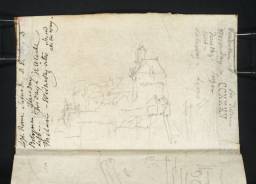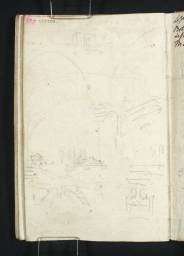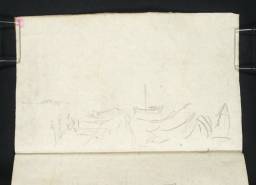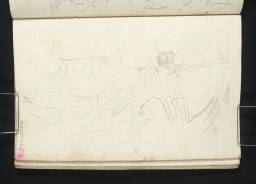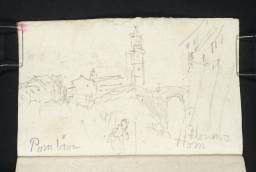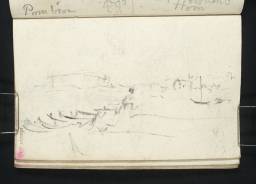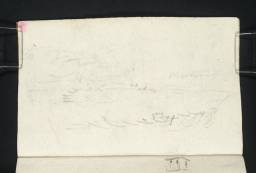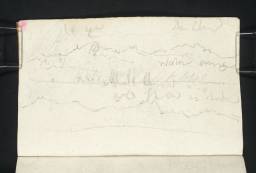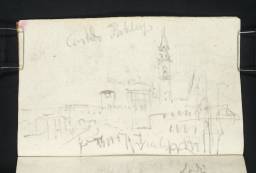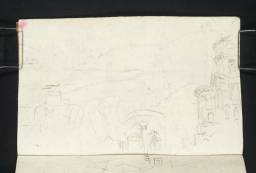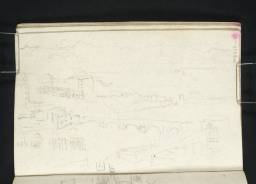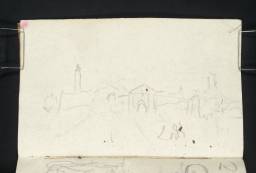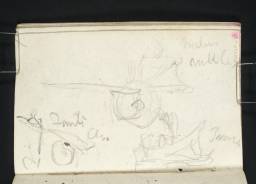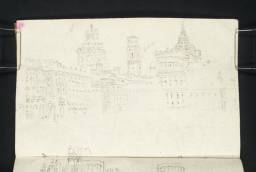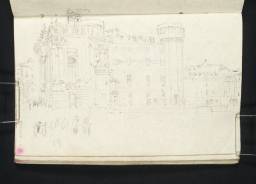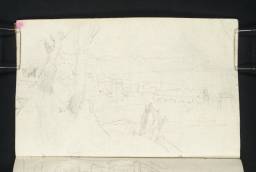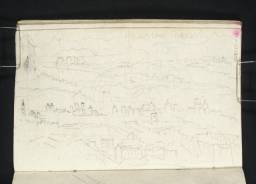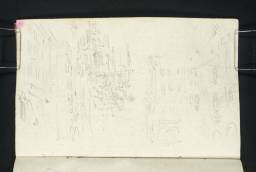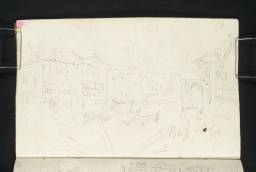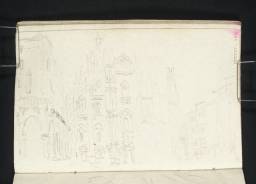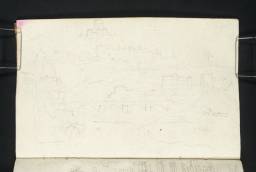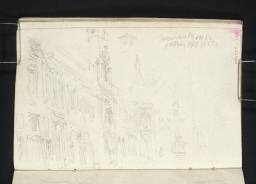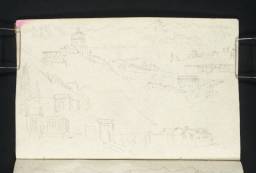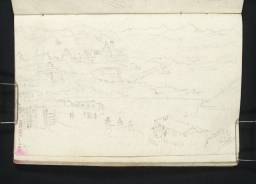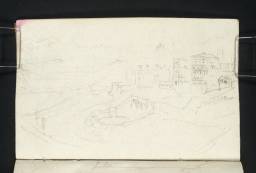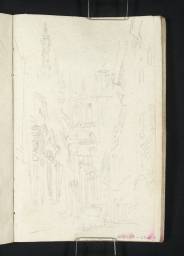Turner Bequest CCXXXV 1–62a
Sketchbook bound in boards, covered in brown parchment with trimmed section revealing underlying card
62 leaves and paste-downs of white wove paper; page size 144 x 90 mm
Inscribed in red ink by John Ruskin ‘R. Turin’ on back cover (D41052) towards bottom, upside down
Numbered 382 as part of the Turner Schedule in 1854 and endorsed by the Executors of the Turner Bequest inside back cover (D41051)
Stamped in black ‘CCXXXV’ on front cover, top right
62 leaves and paste-downs of white wove paper; page size 144 x 90 mm
Inscribed in red ink by John Ruskin ‘R. Turin’ on back cover (D41052) towards bottom, upside down
Numbered 382 as part of the Turner Schedule in 1854 and endorsed by the Executors of the Turner Bequest inside back cover (D41051)
Stamped in black ‘CCXXXV’ on front cover, top right
Accepted by the nation as part of the Turner Bequest 1856
Exhibition history
References
Turner used this sketchbook during his second major tour of France and Italy in 1828–9, as one of eight associated with this journey (see the overall tour Introduction). The seventh book in the overall sequence, it is also the second and final book covering the return leg of the journey, following Turner’s departure from Rome on 3 January 1829. The eighth book is the Roman and French notebook (Tate; Turner Bequest CCXXXVII), which contains sketches and inscriptions spanning the tour.
The title Rome, Turin and Milan was applied by Finberg in his 1909 Inventory of the Turner Bequest.1 While Milan features in ten views (for a full list, see under folio 10 verso; D21683) and Turin in over a dozen (see under folio 7 recto; D21676), Rome does not in fact appear in this sketchbook. When John Ruskin undertook his initial survey of the Turner Bequest, he noted down his cursory impression on a wrapper (since lost, like most) enclosing this ‘Book of careless work at Milan’.2 As he occasionally did, Ruskin also wrote directly on the back cover (D41052), characterising its contents as ‘R Turin’; the phrasing of these two notes, with the ‘R’ taken for Rome, presumably informed Finberg’s wording.
Continuing the itinerary of the previous Rome to Rimini sketchbook (Tate; Turner Bequest CLXXVIII), the contents of which extend to include Bologna, Reggio Emilia and Piacenza, Rome, Turin and Milan focuses primarily on the Lombardy and Piedmont regions of northern Italy. Lodi, Milan, Boffalora Sopra Ticino, Turin, Susa, the Mont Cenis pass and Lanslebourg-Mont-Cenis are among the locations depicted. Alpine views naturally dominate this sketchbook, appearing in over two dozen works. This was Turner’s third encounter with the Franco-Italian Alps, several decades after his first visit in 1802, a formative experience associated with the France, Savoy, Piedmont sketchbook (Tate; Turner Bequest LXXIII). In 1819, during his first major tour of Italy, he travelled south-east through France to Savoy, filling the Paris, France, Savoy 2 sketchbook (Tate; Turner Bequest CLXXIII), before revisiting this region again in the Return from Italy sketchbook of January 1820 (Tate; Turner Bequest CXCII). In the latter half of January 1829, Turner crossed the Alps once more via the Mont Cenis pass, relying on road infrastructure developed by Napoleon in the early 1800s to ease travel between France and Italy.
The contents of Rome, Turin and Milan do not follow the geographical sequence of Turner’s itinerary. Views of Milan and Turin are distributed throughout; studies of Mont Cenis are concentrated at the centre rather than towards the end; and Alpine scenes are dispersed with a similar lack of coherence. Commenting on this ‘curious’ chronology, the Turner scholar Cecilia Powell observed how ‘some of the distances were covered speedily while at other times progress seems to have been extremely slow’.3 Accounting for the ‘jerkiness’ of Turner’s overall progress, Powell pointed to the delays caused by bad weather and snow, which occasionally postponed his departure times.4 Turner may also have travelled by night with the post to save time, limiting his sketching opportunities. After Mont Cenis, there are very few sketches charting Turner’s return journey through France towards London, barring a couple of views identified tentatively as Le Pont-de-Beauvoisin(folio 48 recto; D21757) and Montargis, near Lyon (folio 40 recto; D21734).
A rough itinerary for the return leg of Turner’s journey from Rome is provided by the artist inside the front cover of this sketchbook (D41050), the upper section in ink and the lower in pencil:
Left Rome Saturday 8 E Jany 3
Bologna Tuesday [6 January]
Left - - Friday – 12 o’clock
Milan – Wednesday [14 January] ditto. Snow | all the way
Bologna Tuesday [6 January]
Left - - Friday – 12 o’clock
Milan – Wednesday [14 January] ditto. Snow | all the way
Wend[...] 8 - - for Turin
Monday
Tuesday – Suza
Wed –
Saturday – Lyons
Monday
Tuesday – Suza
Wed –
Saturday – Lyons
It has been assumed that Turner arrived in Lyon on Saturday 24 January.5 He was certainly back in London by early February, in time to attend a meeting at the Royal Academy on 10 February.6 However, as the geographer and Turner researcher Roland Courtot has pointed out, Turner’s brief itinerary (transcribed above) raises questions and has prompted confusion among scholars.7 This is largely due to an incident later recounted by the artist in a letter of 16 February to his friend, the artist Charles Eastlake:
crossed Mont Cenis on a sledge – bivouaced [camped in a temporary shelter] in the snow with fires lighted for 3 Hours on Mont Tarate [sic] while the diligence was righted and dug out, for a Bank of Snow saved it from upsetting – and in the same night we were again turned out to walk up to our knees in new fallen drift to get assistance to dig a channel thro’ it for the coach, so that from Foligno to within 20 miles of Paris I never saw the road but snow!8
In addition to describing this distressing and highly memorable event on Mont Tarare in his letter to Eastlake, Turner also revisited it in a watercolour of 1829, Messieurs les Voyageurs on their return from Italy (par la diligence) in a snow drift upon Mount Tarrar – 22nd of January, 1829 (British Museum, London).9 His diligence is shown toppled over along a mountain road, with the evacuated passengers gathering around a fire behind. As Courtot pointed out, the dating of this event to 22 January is significant. Previous scholarship (with the exception of Thomas Ashby in 1925) tended to assume that Mont Tarare was among the Alps, and that the incident preceded Turner’s arrival in Lyon on Saturday 24 January.10 However, Mont Tarare lies north-west of Lyon among the Beaujolais mountains, so Turner presumably arrived in Lyon before this incident, if the dating of the watercolour is accurate. As Ashby noted in Turner’s Visions of Rome, the notes regarding this second phase of the journey may have been jotted down as a forecast rather than an accurate retrospective account.11
See, for example, Powell 1987, p.165; Saturday ‘26’ January, presumably in error meaning ‘24’, is proposed in Maurice Guillaud and others, Turner en France: aquarelles, peintures, dessins, gravures, carnets de croquis / Turner in France: Watercolours, Paintings, Drawings, Engravings, Sketchbooks, exhibition catalogue, Centre Culturel du Marais, Paris 1981, p.296.
Roland Courtot, ‘15. TB CCXXXV: le carnet du retour d’Italie en 1829’, Carnets de voyage de Turner, accessed 4 September 2024, https://carnetswt.hypotheses.org/4359 .
John Gage, Collected Correspondence of J.M.W. Turner with an Early Diary and a Memoir by George Jones, Oxford 1980, pp.124–6 no. 147.
How to cite
Hannah Kaspar, ‘Rome, Turin and Milan Sketchbook 1829’, sketchbook, November 2024, in David Blayney Brown (ed.), J.M.W. Turner: Sketchbooks, Drawings and Watercolours, Tate Research Publication, February 2025, https://www

